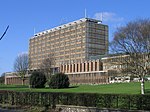Carrow Abbey
1146 establishments in England1538 disestablishments in EnglandBenedictine nunneries in EnglandChristian monasteries established in the 12th centuryGrade I listed buildings in Norfolk ... and 3 more
Grade I listed monasteriesMonasteries in NorfolkReligious organizations established in the 1140s

Carrow Abbey is a former Benedictine priory in Bracondale, southeast Norwich, England. The village on the site used to be called Carrow (there are many alternative spellings) and gives its name to Carrow Road, the football ground of Norwich F.C., located just metres to the north. Granted by charter of King Stephen, the abbey was founded ca. 1146, and became a Grade I listed building in 1954.
Excerpt from the Wikipedia article Carrow Abbey (License: CC BY-SA 3.0, Authors, Images).Carrow Abbey
Bracondale, Norwich Lakenham
Geographical coordinates (GPS) Address External links Nearby Places Show on map
Geographical coordinates (GPS)
| Latitude | Longitude |
|---|---|
| N 52.618 ° | E 1.3108055555556 ° |
Address
Carrow Abbey
Bracondale
NR1 2BF Norwich, Lakenham
England, United Kingdom
Open on Google Maps







